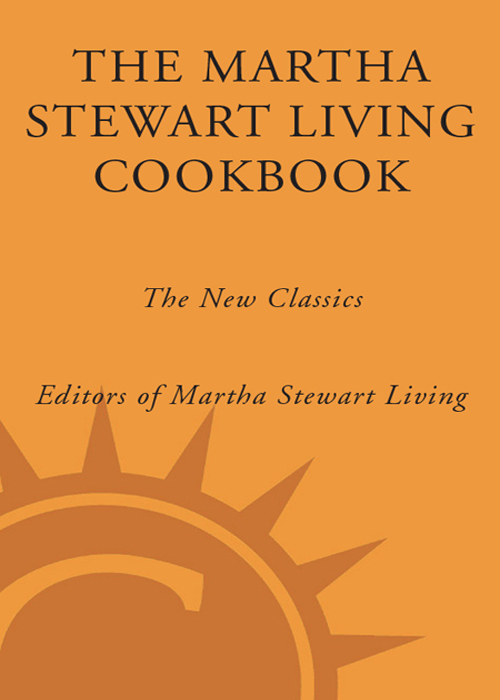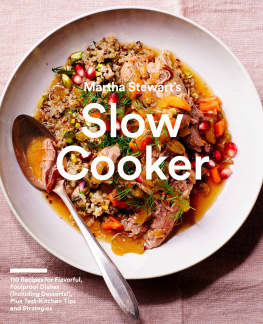

contents

acknowledgments

THE RECIPES IN THIS book represent the creativity and hard work of many people, over many years. A special thank you to our very talented editorial director of food and entertaining, Lucinda Scala Quinn, who leads the team that creates the recipes in Martha Stewart Living, as well as to food editor Jennifer Aaronson and deputy food editor Sarah Carey, who offered careful guidance throughout the creation of this book. Thank you also to the many other food editors, recipe testers, and kitchen assistants who have worked in the Martha Stewart Living test kitchens since 2001, among them Christine Albano, Sara Backhouse, John Barricelli, Tara Bench, Shira Bocar, Frances Boswell, Stephana Bottom, Monita Buchwald, Samantha Connell, Carolyn Coppersmith, Kristine Croker Fiordalis, Stephanie Fletcher, Yolanda Florez, Amy Gropp Forbes, Allison Hedges, Aida Ibarra, Heidi Johannsen, Carmen Juarez, Shelly Kaldunski, Anna Kovel, Judith Lockhart, Rachael Macchiesi, Denise Mickelsen, Claire Perez, Melissa Perry, Elizabeth Pilar, Gertrude Porter, Lori Powell, Darlene Schrack, Nicole Slaven, Susan Spungen, Susan Sugarman, Susan Testa, Laura Trace, Brittany Williams, and Avery Wittkamp.
Their food always looks as delicious as it tastes, as you can see in the photographs in this book. For creating those images, thank you to the brilliant photographers as well as Martha Stewart Living design director James Dunlinson and deputy creative director Ayesha Patel and their teams of art directors and stylists. Thanks also to our photo department, including Heloise Goodman, Andrea Bakacs, Joni Noe, and Alison Vanek Devine.
Producing this book required the dedication of special projects editor in chief Amy Conway, executive editor Ellen Morrissey, and assistant managing editor Robb Riedel. Heartfelt thanks to Evelyn Battaglia, who brought expertise and enthusiasm to every stage of the project and whose considerable talents are reflected throughout the book. Under the direction of art director William van Roden, associate art director Amber Blakesley created the books elegant, modern cover, and worked with Mary Jane Callister on an overall design that is fresh but timeless. Thank you, too, to Denise Clappi, Lori Key, Matt Papa, and Emily Burns for their help with so many details.
As always, our executive team of Gael Towey, Lauren Podlach Stanich, Margaret Roach, and Eric A. Pike lent valuable support to the project. And thanks to our colleagues at Clarkson Potter: Jenny Frost, Lauren Shakely, Doris Cooper, Jane Treuhaft, Amy Boorstein, Mark McCauslin, and Derek Gullino.
introduction

The Martha Stewart Living test kitchens are always exciting and inspiring. There, on the ninth floor of the Starrett-Lehigh building in Manhattan, you will find a big team of talented cooks busy at the stoves and the work stations, mixing, stirring, measuring, chopping, kneading, sauting, tasting, and fine-tuning. Right next door in our photo studios, more food is being prepared and styled for the photographs being taken. And just down the hall, editors are at their computers writing recipes or debating the best way to phrase a step.
This big, bustling operation evolved from a very small start, back in 1990. But the most important things have not changed: I and all of our food editors have always shared a dedication to quality, a passion for the very best ingredients, a thirst for knowledge (and desire to share what we learn), and a sincere appreciation of the ever-changing world of food and cooking. Our food department creates many hundreds of recipes every year; this book contains more than 1,200 of our favorites culled from Martha Stewart Living since 2001. I hope youll try many of them and use them again and again, as I do. And because an avid cook can never have too many fine recipes, I recommend you look at The Martha Stewart Living Cookbook: The Original Classics as well. It contains more than 1,100 recipes published between 1990 and 2000. The two books together make a wonderfully comprehensive set; this one even includes an index for both volumes. You could start on page one of either book, cook every recipe, and never get bored!

pantry

STAPLES

ANCHOVIES These tiny salt-cured fish are a staple of the cuisines of France, Spain, and Italy, where they are used to impart depth of flavor to sauces, such as salsa verde and bagna cauda, as well as to many meat, poultry, and vegetable dishes. When possible, buy anchovies that are salt-packed and sold in jars rather than those packed in oil and sold in tins. To tame their saltiness, rinse anchovies briefly under cold running water before using. Avoid overcooking, or cooking in oil that is too hot, as they will fry and harden instead of dissolving; mashing them first helps them blend quickly. Keep unopened tins at room temperature; once opened, transfer the fillets to an airtight container, cover with oil, and refrigerate for up to a month. Salt-packed anchovies have a much longer shelf life, and will keep for up to a year at room temperature (even after opening).
BEANS Black beans, cannellini beans, and chickpeas are versatileadd them to salads or combine them with rice or pasta for hearty side dishes or meatless main courses. Before using, rinse canned beans under cold running water and allow them to drain thoroughly. Once opened, transfer beans to an airtight container and refrigerate for up to a week.
CANNED MILK (EVAPORATED MILK AND SWEETENED CONDENSED MILK) Both products are made by removing about half the water from fresh milk, but sweetened condensed milk has sugar added while evaporated milk does not. They are not interchangeable. Evaporated milk lends creaminess to sauces and desserts; it can be mixed with an equal amount of water and used in place of fresh milk in a pinch. Sweetened condensed milk has a very sweet, distinctive flavor, and is used in pies, candies, and other desserts; it is the only milk used in dulce de leche, a creamy Spanish sauce with a caramel flavor, and one of three milks in Pastel Tres Leches, a classic Mexican cake. Canned milk can be kept in the pantry for months; once opened, the milk should be refrigerated in an airtight container and used within several days.
CANNED TOMATOES You can find tomatoes in many forms (diced, crushed, seasoned, and so on), but whole tomatoes (in juice, not puree) are the most versatile. The tomatoes will break down over long, slow cooking, making them ideal for stews, braises, and meat sauces. They can also be cut with kitchen scissors or crushed with your hands for use in quick-cooking sauces and dishes or pureed for a smooth consistency (instead of using canned tomato sauce).
Next page








